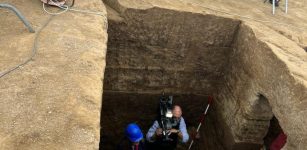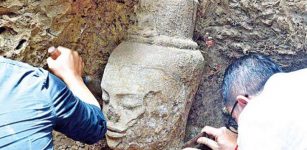Intricate Mazes And Labyrinths: Mysterious Symbols Of Beauty And Confusion Or Communication Signals
A. Sutherland - AncientPages.com - Since ancient times, people have constructed mazes. They were created in countless geometric variations, which are complex and intricate. Mazes and labyrinths have been found on artifacts from the ancient world; from the Bronze Age in Ireland and Spain, to India to North Africa and in the American Southwest.
A fascinating ‘Pebble Labyrinth’ was found on an uninhabited Weir Island, the Gulf of Finland in 1838.
This labyrinth stone layout called 'Weir labyrinth' has the diameter of the outer circle measures only some 6 cubits (2.7 meters), or somewhat more, and the stones are only 5–8, or at most 10, inches thick. Was it just a spontaneous work of some seafarers?
‘... I would not have hesitated for a moment to see here the work of idle seafarers waiting for a wind... if I had not remembered seeing the same shape, much more extensive and built with larger blocks, in a ravine in Lapland near the village of Ponoi..' wrote scholar Dr. Karl Ernst von Baer, when he saw the Weir Labyrinth.
Both maze and labyrinth depict a complex and confusing series of pathways, but they are different.
A maze is a complex, branching puzzle that includes choices of path and direction, while a labyrinth has only a single, non-branching path, which leads to the center. A labyrinth, which is not designed to be difficult to navigate, has a single through-route with twists and turns but without branches. It has only one entrance and that is also the exit.
There is just one path from the entrance to the center.
A maze is a confusing pathway; it is a puzzle that has many branches, choices of path and dead-ends and can be designed with various levels of difficulty and complexity. It also has different entry and exit points.
The earliest labyrinths particularly those mentioned by classic writers are those discovered on Crete and in Egypt
On the island of Sardinia, in the town of Luzzanas, there is a very ancient rock carving depicting a labyrinth and it dates back to 3000 BC and the Syrian labyrinths drawn on potsherds during 1,000 BC and many others found in Scandinavian islands can be traced to the Megalithic period.
Later, the fascinating labyrinth idea was adopted and developed further by the Christian Church in the Middle Ages.
Undoubtedly, this ancient magic symbol was of particular importance and there is a reason to believe that this figure has been known to people for a very long time.
See also:
Secrets Of The Spiral Symbol Left By Ancient Civilizations
Secrets Of The Scarab – Ancient Sacred Symbol In Human History
"It is a confusing path, hard to follow without a thread, but, provided [you are] not devoured at the midpoint, it leads surely, despite twists and turns, back to the beginning." — Plato
A 2,000-year-old square labyrinth has been discovered in Gedimedu, a village 16km from Pollachi, Tamil Nadu state, India. With a complicated network of paths, labyrinths have been a fertility symbol associated with many cultures.
They represent a unique pattern of consciousness and have been used as a meditation tool and a wish-fulfilling symbol since the Neolithic period.
The Gedimedu square labyrinth measures 56 feet X 56 feet and is the second largest ever discovered in India. Interestingly, its pattern is the same seen on the Greek Pylos tablets. The labyrinth's inner walking space varies from 2.6 feet to 3.6 feet and its old name is Seven Round Fort. The entrance is towards the east and the pattern is the same that we see on the clay tablet from Pylos in Greece.
Some of the labyrinths were discovered during the Neolithic period, namely Luzzanas (2,500 BC) in the island of Sardinia.
Our ancestors created mazes and labyrinths but we do not know why these mazes and labyrinths appeared independently all over the world.
Herodotus, a Greek historian wrote in the 5th century, on the complex and intricate architectural construction - a labyrinth, when he described an ancient Egyptian labyrinth: ‘…the Pyramids likewise surpass description, but the Labyrinth surpasses the Pyramids." Also, the Roman historian, Pliny, wrote about ancient labyrinths – mysterious masterworks frequently encountered across Europe and North Africa.
Question is: what does a labyrinth or a maze mean? Is it a message, a communication signal, a symbol of beauty or confusion, or perhaps both?
Solving the ancient mystery of labyrinths has not been an easy task for scholars, but there are speculations, hypotheses, and even science-based set of theories and all of them can be considered as helpful in solving the ancient mystery of labyrinths and mazes.
Written by – A. Sutherland AncientPages.com Staff Writer
Copyright © AncientPages.com All rights reserved. This material may not be published, broadcast, rewritten or redistributed in whole or part without the express written permission of AncientPages.com
More From Ancient Pages
-
 Intact 2,600-Year-Old Etruscan Tomb Opened In Vulci- Exceptionally Rare Artifacts Found Inside
Archaeology | Oct 31, 2023
Intact 2,600-Year-Old Etruscan Tomb Opened In Vulci- Exceptionally Rare Artifacts Found Inside
Archaeology | Oct 31, 2023 -
 Lamplighters In London: An Important Job In The Victorian Era
Ancient History Facts | May 17, 2019
Lamplighters In London: An Important Job In The Victorian Era
Ancient History Facts | May 17, 2019 -
 Partial Skull Fossils Found In China Could Be A New Species -‘A Kind Of Unknown Or New Archaic Human’, Researcher Says
Archaeology | Mar 6, 2017
Partial Skull Fossils Found In China Could Be A New Species -‘A Kind Of Unknown Or New Archaic Human’, Researcher Says
Archaeology | Mar 6, 2017 -
 DNA Sheds Light On Ancient History Of Dogs All The Way To The Ice Age
Archaeology | Oct 30, 2020
DNA Sheds Light On Ancient History Of Dogs All The Way To The Ice Age
Archaeology | Oct 30, 2020 -
 Immortal Mimi Spirits In Beliefs Of Aborigines Of Arnhem Land
Featured Stories | Mar 26, 2020
Immortal Mimi Spirits In Beliefs Of Aborigines Of Arnhem Land
Featured Stories | Mar 26, 2020 -
 Ancient Societies Ruled By Ruthless Dictators – Collapsed
Civilizations | Oct 18, 2020
Ancient Societies Ruled By Ruthless Dictators – Collapsed
Civilizations | Oct 18, 2020 -
 Neanderthals Buried Their Dead And Developed Spirituals Beliefs – Did Neanderthals Practice Religion?
Featured Stories | Dec 28, 2016
Neanderthals Buried Their Dead And Developed Spirituals Beliefs – Did Neanderthals Practice Religion?
Featured Stories | Dec 28, 2016 -
 Sandstone Head Of A Bodhisattva Discovered Near Ta Nei Temple
Archaeology | Oct 15, 2019
Sandstone Head Of A Bodhisattva Discovered Near Ta Nei Temple
Archaeology | Oct 15, 2019 -
 Ancient City Of Knossos – A Cosmopolitan Hub Of The Minoan Civilization And Culture
Civilizations | Jan 8, 2016
Ancient City Of Knossos – A Cosmopolitan Hub Of The Minoan Civilization And Culture
Civilizations | Jan 8, 2016 -
 Antediluvian Time-Capsule Hidden In Forbidden Ancient Egyptian Crypts?
Ancient Mysteries | May 7, 2018
Antediluvian Time-Capsule Hidden In Forbidden Ancient Egyptian Crypts?
Ancient Mysteries | May 7, 2018 -
 Memory Of Palmyra’s Ancient Ruins Preserved Thanks To One Man’s Dedication And Mini Models Of Lost Temples
Archaeology | Mar 24, 2021
Memory Of Palmyra’s Ancient Ruins Preserved Thanks To One Man’s Dedication And Mini Models Of Lost Temples
Archaeology | Mar 24, 2021 -
 Three Unusual Celestial Journeys And The Chosen Ones Initiated Into The Secrets Of The Gods
Ancient Mysteries | Jul 26, 2021
Three Unusual Celestial Journeys And The Chosen Ones Initiated Into The Secrets Of The Gods
Ancient Mysteries | Jul 26, 2021 -
 Burial Of Queen Of Emma Of Normandy Discovered In Winchester Castle
Archaeology | Nov 2, 2021
Burial Of Queen Of Emma Of Normandy Discovered In Winchester Castle
Archaeology | Nov 2, 2021 -
 Burnt Mound Complex Dated To Bronze Age – Uncovered At Suffolk Site
Archaeology | Jun 19, 2023
Burnt Mound Complex Dated To Bronze Age – Uncovered At Suffolk Site
Archaeology | Jun 19, 2023 -
![Horses in the Eurasian steppes: Already 5000 years ago, they served pastoralists as a source of milk and a means of… [more] © A. Senokosov](https://www.ancientpages.com/wp-content/uploads/2021/09/pastoraliststeppe15-307x150.jpg) Milk Enabled Massive Steppe Migration – A New Study
Archaeology | Sep 24, 2021
Milk Enabled Massive Steppe Migration – A New Study
Archaeology | Sep 24, 2021 -
 Ancient Mysteries In The Amazon Jungle – Strange White Men With Glowing Eyes – Part 1
Ancient Mysteries | May 28, 2018
Ancient Mysteries In The Amazon Jungle – Strange White Men With Glowing Eyes – Part 1
Ancient Mysteries | May 28, 2018 -
 Ancient City Of Koh Ker Was Occupied Much Longer Than Previously Thought
Archaeology | Oct 12, 2018
Ancient City Of Koh Ker Was Occupied Much Longer Than Previously Thought
Archaeology | Oct 12, 2018 -
 Cannabis Protected India’s Famous Ellora Caves From Decay For 1,500 Years
Archaeology | Mar 12, 2016
Cannabis Protected India’s Famous Ellora Caves From Decay For 1,500 Years
Archaeology | Mar 12, 2016 -
 Shin-Au-Av – Secret Ancient Underground City Hidden Beneath Death Valley
Featured Stories | Jun 6, 2024
Shin-Au-Av – Secret Ancient Underground City Hidden Beneath Death Valley
Featured Stories | Jun 6, 2024 -
 Have Archaeologists Found Evidence Of A Universal Ancient Civilization That Gave Birth To All Other Cultures Across The World?
Featured Stories | Mar 13, 2025
Have Archaeologists Found Evidence Of A Universal Ancient Civilization That Gave Birth To All Other Cultures Across The World?
Featured Stories | Mar 13, 2025








